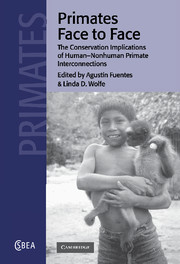Part 2 - Cultural views of nonhuman primates
Published online by Cambridge University Press: 20 October 2009
Summary
In many areas of the world human and nonhuman primates are intertwined in important cultural and ecological contexts. While human and nonhuman organisms frequently share common environments, or space, some nonhuman organisms play an additional significant role in human ‘place’. This place is the reality created by the human cultural incorporation, utilization and modification of the environment or habitat in which they live. In many parts of the circumequatorial world, especially Amazonia, nonhuman primates are central to human nutritional and social realities. In this section the authors seek to provide the reader access to the intricate, cultural interconnections between humans and a few species of monkey and ape.
Loretta Cormier's discussion of the Guajá of Eastern Amazonia (Chapter 4) provides a glimpse of a dramatic and complex series of social and mythological relationships involving humans and monkeys. Simultaneously playing central nutritional and cultural roles, the monkeys form an integral component of Guajá life. This example represents an extreme level of cross-primate connectivity and at the same time illustrates the amazing diversity and malleability of human cultural kinship systems.
In Chapter 5 Manuel Lizarralde contextualizes the discussion under the rubric of ethnoecology and presents a culturally based account of the role and importance of monkeys to the Bari of Venezuela.
- Type
- Chapter
- Information
- Primates Face to FaceThe Conservation Implications of Human-nonhuman Primate Interconnections, pp. 61 - 62Publisher: Cambridge University PressPrint publication year: 2002
- 1
- Cited by



